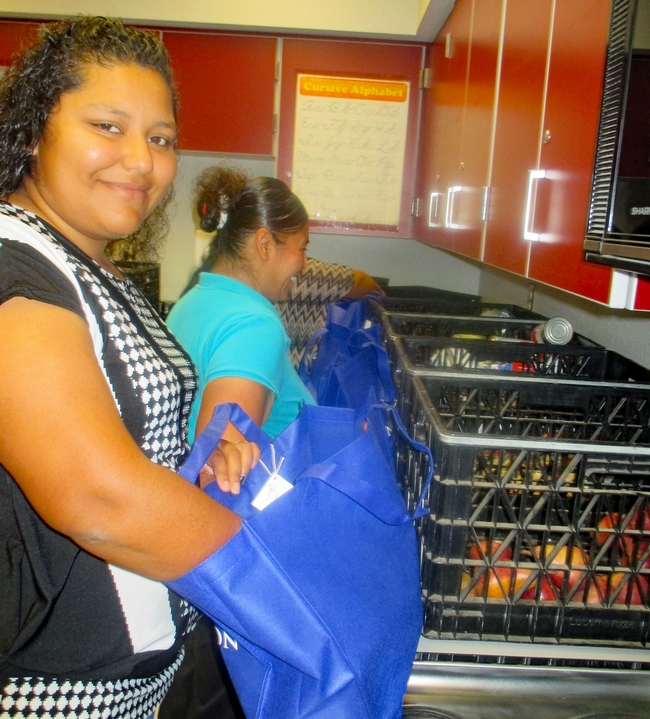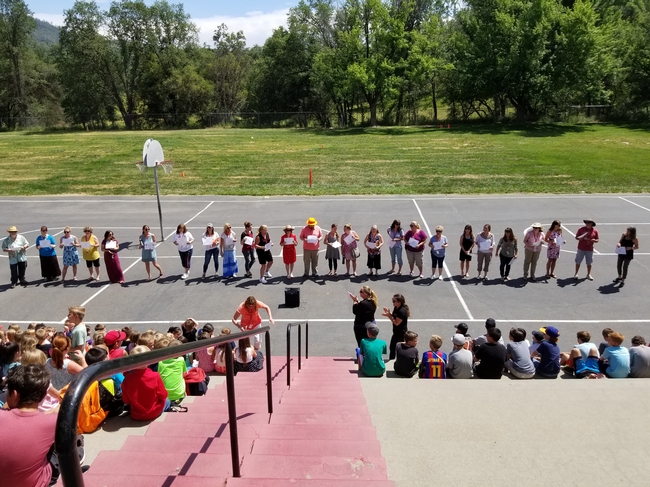Posts Tagged: SNAP-Ed
SNAP-Ed: It's a life changer
In January, more than 600 Supplemental Nutrition Assistance Program – Education (SNAP-Ed) professionals across California gathered in Sacramento for the SNAP-Ed Local Implementing Agency Forum. This two-day annual gathering celebrates SNAP-Ed work, offers a platform to share lessons learned, and provides training opportunities. The 2018 theme was: “Building Power through Stories of Change”.
During one of the plenary sessions, Stories of Change: Voices from the Community, we heard directly from participants about their struggles to achieve good health in difficult situations – where time and money are limited. Listening to SNAP-Ed participants' stories of life changing experiences in health and fitness was captivating. However, one thing was clear – it all began with first steps: deciding to change, walking into a SNAP-Ed class, bonding with a compelling educator. These often invisible steps are needed to make enduring change. The stories solidified the importance and impact of SNAP-Ed in the community.
The SNAP-Ed LIA Forum also showcased county work through a poster session. During this time, we heard UC CalFresh Nutrition Education Program educators and administrators discuss their work along with their SNAP-Ed colleagues. The level of commitment and collaboration that is occurring every day across the state was compelling.
Here are just a couple UC CalFresh stories:
Creating CHEFs
In Stanislaus County, 40 percent of low-income families are food insecure. The United Way, UC CalFresh Nutrition Education, Second Harvest Food Bank, and Caswell and Bret Hart elementary schools worked together to find ways to increase elementary school students and their families' access to and consumption of healthy food and beverages.
They created the CHEF program; CHEF stands for Cooking, Healthy Eating & Food. Participant's help prepare meals during nutrition education classes. They take home ingredients to make the recipe for their families at the end of each 4- to 6-week series. The classes teach families about MyPlate and how to make long-term, healthier choices by reading labels, exercising portion control, and shopping on a budget.
CHEF also provides more than 340 children in the two afterschool programs with 18-pound bags of food twice per month. From 2016 to date, 197 adults participated in nutrition education classes. More than 200,000 pounds of healthy food were provided to Stanislaus County families.
Stepping it up
In Tuolumne County, the UC Cooperative Extension Central Sierra region helped start the "Tuolumne County: Step It Up" campaign across the school district. Thirty percent of the population in Tuolumne County is overweight or obese. The UCCE staff considered how to assist in reducing this statistic and provide a model for a simple way to achieve a healthier lifestyle.
Physical activity is an important aspect of health in children. Benefits include:
- Improved heart health
- Increased muscle strength and bone health
- Improved weight control
- Decreased risk for many chronic diseases
- Positive effect on mental health
- Inclination to continue healthy lifestyle into adulthood
- Improved educational outcomes
UC CalFresh, Tuolumne County Schools, County Public Health, and the Local ATCAA Food Bank invited school staff to form teams at their schools for a six-week competition, logging their steps along the way. The competition ran from April 6, 2017, to National Walking Day, May 17, 2017. The data were captured through online spreadsheets and emailed weekly by a designated team captain.
The ‘Step It Up' competition garnered significant community support. Local businesses donated prizes for winning staff, which were presented at school-wide assemblies with certificates for each participant. Students contributed to their step count through recess walks, “walk-and-talk” roving lectures, or school-wide walking mornings.
With five teams and over 180 participants, the steppers collectively walked 25,081 miles. The winning school was acknowledged by their district school board and have enacted a policy dedicating time every Wednesday morning to walk as a school.
SNAP-Ed: It's a life changer!
As members of the community, UCCE educators and staff lead the way to build resources that establish healthy lifestyles where they live and serve. Ultimately, their daily work is building the capacity for local institutions and leaders to make a long lasting difference. Hats off to all of you, your partners and community members – your efforts make SNAP-Ed a life changer!
Author: Andra Nicoli, UC CalFresh State Office, with county contributions from Jaci Westbrook, Gretchen Birtwhistle and Wylie Skillman
Tackling childhood obesity: A systems change approach
On paper, the charge was clear: launch a statewide effort to integrate the nutrition education programs of USDA SNAP-Ed funded partners. Address childhood obesity and food insecurity holistically, yet specifically. Do this through policy, systems and environmental approaches that will leverage community participation and resources in order to create sustainability at the local level, and do it as funding is declining in SNAP-Ed programs.
But what would this integrated effort actually look like in practice? How could a single effort weave together the many agencies, actors, and systems that influence a child's earliest years, a family's food selection, and school and community activities? How could the people around a table, some meeting for the first time, coalesce around a shared vision, let alone mutually agreed strategies?
A problem as multifaceted as childhood obesity requires a similarly complex public health approach to meet the challenge. It is with this charge that over the past four years UC CalFresh has been working across California on nutrition education and obesity prevention with the California Department of Social Services, the California Department of Public Health, the California Department of Aging, and Catholic Charities to redefine Supplemental Nutrition Assistance Program-Education (SNAP-Ed, which is funded by the USDA Food and Nutrition Service).
The SNAP-Ed mission in California is to inspire and empower underserved Californians to improve their health and the health of their communities by promoting awareness, education, and community change through diverse partnerships, resulting in healthy eating and active living.
SNAP-Ed work is executed through county-led integrated workplans which now embody policy, systems and environmental (PSE) change in the body of work previously seen as a direct education program in schools and communities. Adding PSE activities to SNAP-Ed work acknowledges that a systems change approach that comprehensively addresses nutritional health where people live, learn, work, shop and play most effectively assures that children and their families will benefit from SNAP-Ed educational efforts.
Technical assistance through education on food and food resource management coupled with assisting community members in making changes to their environment is a viable method of creating sustainable change. These types of comprehensive changes in schools and communities have been cited by a recent Robert Wood Johnson report to help children grow up at a healthy weight.
- Tackling obstacles such as access to affordable fresh fruit and vegetables, safe areas to recreate, safe routes to school, and programs/curricula that encourage physical activity are important aspects of initiating long lasting community health and lifestyle changes.
- Teaming with the Department of Transportation or environmental programs such as Resilient Schools can fuse nutritional work with those working in other areas that contribute to and foster a safe, healthy community.
- Wellness policies in schools that encourage good nutrition and physical activity institutionalize healthy lifestyle choices.
- Programs like the Smarter Lunchroom Movement help schools and students make the healthy choice in food and beverages the easy choice.
- Environmental supports such as murals in the lunchroom or on school/community grounds visually reinforce key messages. On the playground, stencils depicting fruits and vegetables with key messages help motivate student's movement and play while reinforcing lessons learned in the classroom.
- Garden-based learning facilitates student and community members' exploration of low-cost methods to add fresh fruits and vegetables to their daily meal plan. Research shows that nutrition and gardening experiences, linked to academic standards for a specific age group, can increase vegetable and fruit consumption and physical activity.
Now, let's explore how these changes in the type of work executed through SNAP-Ed is poising California communities to tackle childhood obesity.
There is general agreement through research that the first years of children's lives can determine the rest of their development. Across ideological divides, there is consensus that investing early makes sense — it helps children develop healthy habits that can last a lifetime — creating a high return on the investment of public dollars.
As described, SNAP-Ed funded and non-funded partners in communities are tackling childhood obesity and food insecurity on multiple fronts. It has been initiated with five broad-based levers for change:
- Offering evidence-based direct nutrition education curricula and technical assistance
- Developing state and local partnerships
- Using data to inform strategies
- Building commitment among stakeholders
- Tackling policy and practice change
However, in the end, support in counties from SNAP-Ed funded partners requires community leadership and long term ownership to succeed. Each community is armed with essential knowledge about local context to make sense of these levers and to pursue emergent opportunities.
At the state and local level, the development and implementation of integrated workplans with community members input is a blueprint charting each counties course.
At the state level, the past four years of developing SNAP-Ed integrated workplans created several lessons in systems change evolution:
Listen and learn
The more we listen and support community members, bringing their ideas to the forefront of our work, the more sustainable our efforts will be.
Connect the dots and engage
Fragmentation and silos create a diverse but disconnected sector. Communicate and connect as much as possible.
Create mission and values statements that unify - then operate transparently
As you get to know the community members and organizations that you are working with— together create your mission and values statement and make that your solidifying “call to arms” — then work transparently to fulfill your mutual objectives.
Embrace tensions
Different settings, standards, and social norms create tension — successful systems change efforts face, rather than circumvent, these tensions…be respectful and “lean in”.
Foster a long term approach/celebrate short term “wins”
As we review the many factors that lead to childhood obesity and food insecurity, use long term systems change strategies, foster sustained commitment, and celebrate successes, no matter how small.
Be adaptable but purposeful
Reflect on how different organizations work and understand that your perspective may be a result of your vantage point. Try to be in another organization's or person's shoes, recognize their impediments, then work together with this in mind. Good strategies are shaped by reflection and steered with an understanding that there may be a need for course correction.
Keep a unified resolve
A recent Robert Wood Johnson Foundation report concluded that between 2005 and 2010 California saw “a modest but significant decline” in childhood obesity of 1.1 percent in grades 5, 7 and 9. In addition, a 2013 Centers for Disease Control and Prevention report indicated progress in the health of California preschoolers enrolled in federal health and nutrition programs. The report cited that “obesity rates among 2-4 yr olds from low income families dropped 2.9 percent from 17.7 percent in 2008 to 16.8 percent in 2011.” This data speaks to the significance of a comprehensive approach in preventing childhood obesity. Further, it emphasizes the importance of the teamwork provided by a network of state and local agencies, acting with community members, to make a difference in the lives of children.
California data reported by the 2016 Robert Wood Johnson Foundation:
- Since 2004, schools have removed soda and other sugar sweetened beverages from premises.
- Since 2007, schools have limited the calories, fat saturated, fat and sugar in snacks sold on their premises.
- Since 2012, school districts have been required to make free, fresh drinking water available in school food service areas.
- Since 2006, $40 million has been committed in annual dedicated state funding for elementary school physical education.





